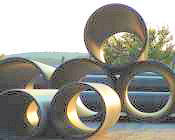 HDPE
Pressure Pipe HDPE
Pressure Pipe
Oxford Plastics manufactures
hdpe pressure pipe for a broad and diverse assortment of
applications. Hdpe pressure pipe is made from high
density polyethylene which is a crystalline resin or polymer known
for its flexibility, toughness and chemical resistance. These
features make hdpe pressure pipe well suited for those applications
or industries requiring a pipe that is strong, durable, corrosion
resistant and yet flexible enough to be assembled and installed
in the most inaccessible and harsh environments. It is the preferred
pipe of choice for most trenchless technologies like pipe bursting
and horizontal direction drilling. If you have a project requiring
a piping solution that can handle extreme loads of pressure under
harsh conditions, hdpe pressure pipe is definitely worth considering.
Construction and Features of HDPE Pressure
Pipe
Our HDPE PE 3408 pipe is manufactured in accordance with
AWWA, ASTM, FM, CSA, BNQ, and NSF Standards. Made from a high density
polyethylene polymer, hdpe pipe has certain physical characteristics
that make it an attractive pressure piping solution. Because of
its molecular structure (much longer chains with fewer side branching)
polyethylene pipe has greater density and a crystallinity level
in the range of 85%. As a rule, when the density increases, the
stiffness, harness, strength, heat distortion point, and ability
to transmit gasses increases. When density decreases, impact strength
and stress crack resistance increases. (Stress cracking is a surface
change that polyethylene will undergo when exposed to oils, gasoline
and other hydrocarbons). Rated at a density range of 0.941 to 0.965
gr/cc, hdpe pressure pipe is superior in stiffness, hardness and
strength making it ideal for pressure applications.
The molecular structure of hdpe pipe gives it certain advantages
over other plastic pipe. Most importantly, it can handle greater
pressures under extremely corrosive conditions. For instance, it
can be buried to great depths and can tolerate severe soil strain
and soil movements (rise or settlement). It is even earthquake tolerant…being
seismically qualified in the lab and field proven. When buried at
these great depths, it also helps when a piping system is capable
of handling the transfer of extremely corrosive materials, i.e.,
industrial wastes and chemical acids.
Applications of
HDPE Pressure Pipe
Our hdpe pressure pipe was manufactured for
a wide range of industrial, commercial and residential applications.
Our broad experience with industries from construction and waste
to agriculture and mining, has helped us to develop pressure
pipe and piping systems that can operate under great
pressure and in very corrosive environments. This makes our pipe
well suited for use as watermain, landfill collection pipe, drainage
pipe in highway construction, agriculture, mining, and irrigation
industries, and as industrial transfer pipe for abrasive materials.
The physical toughness of this pipe, when combined with its light
weight and flexibility, makes it perfect for those situations where
trenchless technologies are required.

Advantages
of HDPE Pressure Pipe
HDPE pressure pipe is probably your
best choice as a pressure piping solution for two important reasons.
Since hdpe pressure pipe is fusion welded together and the weld
is as strong as the original pipe, it is a monolithic or
one piece pressure piping solution. This makes it ideal for pressure
applications compared to other piping materials such as PVC or ductile
iron pipe, and others, which have a bell and spigot, or possibly
a flange joint every few meters making them susceptible to possible
leaks or pipe/pressure failure. Secondly, when any pipe or piping
system is under extremely high pressure, the joints must be restrained
to keep from bursting apart. In most cases, joints, bends, tees,
caps, etc., are anchored with mechanical restraints or blocks of
concrete, so that the joint doesn't pull apart. A concrete block
at a restrained joint is called a thrust block. Hdpe pipe, on the
other hand, is one continuous piece making it self-restrained,
i.e., requiring no mechanical restraint.
In addition to the
various dealers that we have throughout North America, our staff
are ready to assist you with your technical and design questions.
Our toll free telephone
number (1.800.263.0502) will reach us from anywhere in the
USA and Canada. If you have any questions, don't hesitate to call
us and thank you visiting our website.
Contact
us today by email or our toll free number:
sales@oxfordplasticsinc.com
1.800.263.0502
|

 HDPE
Pressure Pipe
HDPE
Pressure Pipe 